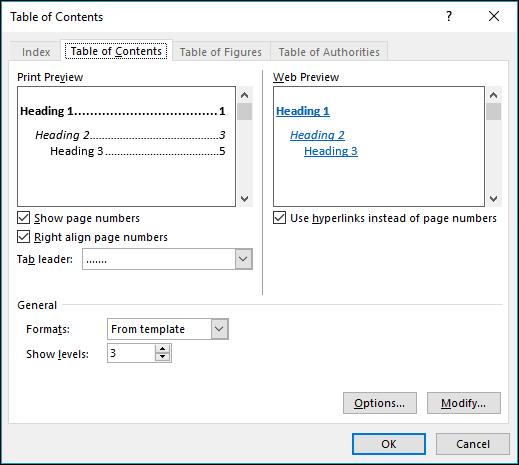

Please note that the location of the Normal.dotm file shown below will be correct for most Windows users. Warning: Deleting the Normal.dotm file will delete all existing custom themes, changes to your default font, other custom styles, and macros. Word will then create a new Normal.dotm file the next time you open the software. If it won’t delete using the method above, you can delete the existing Normal.dotm file.

Your custom heading styles are stored in the Normal.dotm template file in Windows.
CREATE TABLE OF CONTENTS IN WORD MAC HOW TO
Remove from Style Gallery option Bonus Section: How to Delete a Custom Style that Won’t Delete Right-click the heading style in the Style gallery, and then select Remove from Style Gallery in the shortcut menu.įigure 13.If your custom heading style won’t delete, please follow the steps in the bonus section below. However, sometimes this process does not work. The following step shows how to delete a custom heading style. Note that you may have to open the Style gallery or perform another function in the ribbon before the style appears in the gallery for the first time. Your new heading style should now appear when you open a new document. “New documents based on this template” option Select New documents based on this template in the Modify Style dialog box.įigure 11.Right-click the style in the Style gallery, and then select Modify from the shortcut menu.The following steps show how to add your new style to Word’s normal template so it will be available for future use. How to Save a Custom Heading Style for Future Use You can now apply the new heading style to any text in your document. Your new heading style should appear in the Style gallery. Type a name in the Create New Style from Formatting dialog box.Select Create a Style from the Styles menu.Right-click the text, and then select Styles from the Mini toolbar.įigure 5.Text with formatting options from the Font and Paragraph group Select the text, and then use the options in the Font and Paragraph group to format it with the font, font size, font color, emphasis, and alignment you want to include in your new heading style.įigure 4.(It can be a real heading or sample text.) The new text will appear with the built-in style of the heading level you chose in step 2.įigure 3. (For example, heading level 4 will appear after you use level 3.) Additional heading levels will appear in the gallery after you use lower levels in your document.Remember that you are creating a new heading level style, but you won’t be replacing the existing built-in heading level style.This step is important because your new heading won’t be included in your table of contents or outline without an assigned level.Select the heading level you would like to create in the Style gallery.Si mi respuesta te ha servido, márcala como solución o como útil. _ If an answer provides a solution or you find it helpful, please mark it accordingly. All similar entries in the TOC will change accordingly. Thus, all you need to do is select a TOC entry (clicking on the left margin will be easier) and modify the way it looks. By default, the TOC styles already have the "Automatically update" feature enabled.The texts with Heading 1 will appear in the TOC and Word will apply to them another built-in style called TOC 1.By default, the TOC will be created using the text from those three levels, but you can specify more levels or less levels. Once you've defined, say, three levels of titles (Headings 1 to 3), insert the Table of Contents.Of a title with Heading 1 style, all titles of that level will also changes as the style is "redefined by example." For instance, if you change the indents or font or point size Access Format > Style, locate style Heading 1, modify it to add a checkmark in "Automatically update." This lets you change the style's definition as you modify a title to suit your preferences.Apply built-in style Heading 2 to the second level of titles in your text.Apply built-in style Heading 1 to all the main titles in your text (select the complete title and then choose the style).


 0 kommentar(er)
0 kommentar(er)
